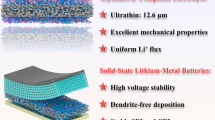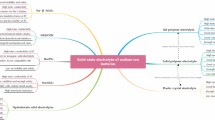Abstract
Since the mechanism of charge storage in electrical double-layer capacitors (EDLCs) relies on diffusion of ions into the pores of the electrodes, in general, a much lower capacitance is expected for gel-based electrolytes than liquid electrolytes. However, in this work, we have found that the specific capacitance in gel-based electrolytes made of polyvinyl alcohol (PVA) and an acid (H2SO4 or H3PO4) is even higher than the specific capacitances of similar devices with liquid acid-based electrolytes. We have discovered that the reason is due to the gel being a redox active material with the capability of charge storage in the volume of the electrolyte. In this work, solid-state and flexible devices with both H2SO4-PVA and H3PO4–PVA electrolytes were fabricated and characterized. The cyclic voltammetry (CV) and electrochemical impedance spectroscopy (EIS) methods were applied to estimate the capacitance associated to the gel electrolytes. Also, a relatively high cycling stability of 97.5% for H2SO4-PVA and 95% for H3PO4-PVA was obtained after 1000 charging-discharging cycles. A mechanism of charge storage is proposed to explain the redox active behavior of the gel electrolyte. The presented results are promising for employment of PVA gel electrolytes in some low-cost applications.









Similar content being viewed by others
References
Choudhary N, Li C, Moore J, Nagaiah N, Zhai L, Jung Y, Thomas J (2017) Asymmetric supercapacitor electrodes and devices. Adv Mater 29(21):1605336
Lu X, Yu M, Wang G, Tong Y, Li Y (2014) Flexible solid-state supercapacitors: design, fabrication and applications. Energy Environ Sci 7(7):2160–2181
Pandey G, Hashmi S, Kumar Y (2010) Performance studies of activated charcoal based electrical double layer capacitors with ionic liquid gel polymer electrolytes. Energy Fuel 24(12):6644–6652
González A, Goikolea E, Barrena JA, Mysyk R (2016) Review on supercapacitors: technologies and materials. Renew Sust Energ Rev 58:1189–1206
Liu Q, Nayfeh MH, Yau S-T (2010) Brushed-on flexible supercapacitor sheets using a nanocomposite of polyaniline and carbon nanotubes. J Power Sources 195(21):7480–7483
Kang YJ, Chung H, Han C-H, Kim W (2012) All-solid-state flexible supercapacitors based on papers coated with carbon nanotubes and ionic-liquid-based gel electrolytes. Nanotechnol 23(6):065401
Xiao X, Li T, Yang P, Gao Y, Jin H, Ni W, Zhan W, Zhang X, Cao Y, Zhong J (2012) Fiber-based all-solid-state flexible supercapacitors for self-powered systems. ACS Nano 6(10):9200–9206
Wang S, Pei B, Zhao X, Dryfe RA (2013) Highly porous graphene on carbon cloth as advanced electrodes for flexible all-solid-state supercapacitors. Nano Energy 2(4):530–536
Xu Y, Lin Z, Huang X, Liu Y, Huang Y, Duan X (2013) Flexible solid-state supercapacitors based on three-dimensional graphene hydrogel films. ACS Nano 7(5):4042–4049
Lu X, Wang G, Zhai T, Yu M, Xie S, Ling Y, Liang C, Tong Y, Li Y (2012) Stabilized TiN nanowire arrays for high-performance and flexible supercapacitors. Nano Lett 12(10):5376–5381
Ma W, Chen S, Yang S, Chen W, Weng W, Zhu M (2016) Bottom-up fabrication of activated carbon fiber for all-solid-state supercapacitor with excellent electrochemical performance. ACS Appl Mater Interfaces 8(23):14622–14627
Ren J, Li L, Chen C, Chen X, Cai Z, Qiu L, Wang Y, Zhu X, Peng H (2013) Twisting carbon nanotube fibers for both wire-shaped micro-supercapacitor and micro-battery. Adv Mater 25(8):1155–1159
Hu L, Choi JW, Yang Y, Jeong S, La Mantia F, Cui L-F, Cui Y (2009) Highly conductive paper for energy-storage devices. Proc Natl Acad Sci 106(51):21490–21494
Zdrojek M, Gebicki W, Jastrzebski C, Melin T, Huczko A (2004) Studies of multiwall carbon nanotubes using Raman spectroscopy and atomic force microscopy. Solid State Phenom 99:265–268
Simon P, Gogotsi Y (2008) Materials for electrochemical capacitors. Nat Mater 7(11):845–854
Simon P, Burke A (2008) Nanostructured carbons: double-layer capacitance and more. Electrochem Soc Interface 17:38
Li H, Wang J, Chu Q, Wang Z, Zhang F, Wang S (2009) Theoretical and experimental specific capacitance of polyaniline in sulfuric acid. J Power Sources 190(2):578–586
Hu C-C, Tsou T-W (2002) Ideal capacitive behavior of hydrous manganese oxide prepared by anodic deposition. Electrochem Commun 4(2):105–109
Senthilkumar S, Selvan RK, Ponpandian N, Melo J (2012) Redox additive aqueous polymer gel electrolyte for an electric double layer capacitor. RSC Adv 2(24):8937–8940
Kim BK, Sy S, Yu A, Zhang J (2015) Electrochemical supercapacitors for energy storage and conversion. Handbook of Clean Energy Systems:1–25
Tsay K-C, Zhang L, Zhang J (2012) Effects of electrode layer composition/thickness and electrolyte concentration on both specific capacitance and energy density of supercapacitor. Electrochim Acta 60:428–436
Gao H, Lian K (2012) Advanced proton conducting membrane for ultra-high rate solid flexible electrochemical capacitors. J Mater Chem 22(39):21272–21278
Aljafari B, Takshi A (2018) Gel electrolyte based supercapacitors with higher capacitances and lower resistances than devices with a liquid electrolyte. MRS Adv 3(22):1261–1267
Yu H, Wu J, Fan L, Lin Y, Xu K, Tang Z, Cheng C, Tang S, Lin J, Huang M (2012) A novel redox-mediated gel polymer electrolyte for high-performance supercapacitor. J Power Sources 198:402–407
Yu H, Wu J, Fan L, Xu K, Zhong X, Lin Y, Lin J (2011) Improvement of the performance for quasi-solid-state supercapacitor by using PVA–KOH–KI polymer gel electrolyte. Electrochim Acta 56(20):6881–6886
Zhong J, Fan L-Q, Wu X, Wu J-H, Liu G-J, Lin J-M, Huang M-L, Wei Y-L (2015) Improved energy density of quasi-solid-state supercapacitors using sandwich-type redox-active gel polymer electrolytes. Electrochim Acta 166:150–156
Funding
This work was financially supported by a grant from National Science Foundation (NSF 1400017) and a grant from Community Foundation of Tampa Bay.
Author information
Authors and Affiliations
Corresponding author
Electronic supplementary material
ESM 1
(DOCX 1444 kb)
Rights and permissions
About this article
Cite this article
Aljafari, B., Alamro, T., Ram, M.K. et al. Polyvinyl alcohol-acid redox active gel electrolytes for electrical double-layer capacitor devices. J Solid State Electrochem 23, 125–133 (2019). https://doi.org/10.1007/s10008-018-4120-y
Received:
Revised:
Accepted:
Published:
Issue Date:
DOI: https://doi.org/10.1007/s10008-018-4120-y




